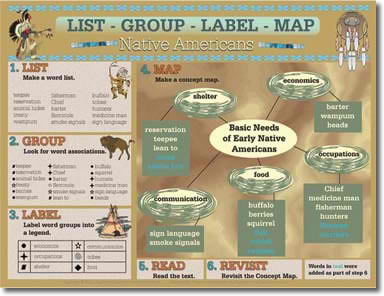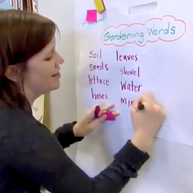Categorizing listed words, through grouping and labeling, helps students organize new concepts in relation to previously learned concepts." (Reading Rockets, 2015).
List-Group-Label
"List-group-label is a form of semantic mapping. The strategy encourages students to improve their vocabulary and categorization skills and learn to organize concepts." (Reading Rockets, 2015). The first step, list, is when the class brainstorms ideas that deal with a large topic. The next step is group. During grouping, students take their listed ideas and group them into certain categories. After students have come up with all of their categories, they label the groups into categories. When students make connections between the topics they are reading, they will comprehend the text better. List-Group-Label is known to improve existing vocabulary and organize verbal concepts for students. This strategy was developed to assist students in remembering, categorizing, and organizing specific terms to a content area. According to Boling and Evans, using list-group-label increases students remember their vocabulary to a specialized content area such as language arts, math, science, and social studies (Boling and Evans, 2008). This strategy is proven to be effective in vocabulary development and lead to literacy skills. "Students need to connect familiar words with new words, expanding their conceptual understanding of vocabulary. Then, during and after reading, they revisit their categories to expand and make changes." (Miller, Veatch, 2011).
Teachers choose to use list-group-label because:
Teachers choose to use list-group-label because:
- "It helps students organize their understanding of specific vocabulary and concepts.
- It builds on students' prior knowledge about a topic.
- It actively engages students in learning new vocabulary and content by activating their critical thinking skills.
- It teaches categorizing and labeling skills." (Reading Rockets, 2015).
|
|
|
How to use List-Group-Label
Benefits of List-Group-LabelBenefits for students:
Specific Learning Disability:
Some students have learning disability such as memories, vocabulary, language, communication, and so one. For student who struggle with one of these examples the List-Group-Label would allow them to conceptually see and be hands on in their learn to add an additional support. |
Example Lesson PlansDifferentiation
"Students need to connect familiar words with new words, expanding their conceptual understanding of vocabulary. Then, during and after reading, they revisit their categories to expand and make changes." (Miller, Veatch, 2011). "By revisiting during and after reading, the teacher can ensure that students are learning the word meaning that is connected to the area of study." (Miller, Veatch, 2011). |
Content Area List-Group-Label Lesson
Reading: While reading a story, students and the teacher can come up with a common theme (ex: Arctic animals). The teacher is going to write the theme on the whiteboard and the students are going to brainstorm ideas (ex: polar bear, arctic hare, penguin, seals). Once these are listed, the students are going to come up with categories to fit all of their ideas into (ex: animals with fur, animals that live in the water). Once all of the ideas are placed into categories, the students will label the categories. This entire process will help students prepare for what they are about to read about. It is activating their prior knowledge, as well as making them create connections between their ideas. This is a great activity to use before or after reading a story. If used before, it will help students prepare. If used after, it will help students reflect on their readings as well as make a deeper connection to the text.
Science: While working with a new science topic, it is common practice to ask students what they know about the topic before jumping into it. This way, you can clear up any misconceptions and help them start thinking about the content before the lesson. Using a list-group-label could be the start to a great open-ended discussion about whatever science topic is next. This would be a great informal assessment for teachers to see how much students actually know about a topic before teaching it.
Math: Math list-group-labels are about the same as a science list-group-label. Teachers want to use this before going through a new lesson to clear up any misconceptions and hear what students already know about a topic. If listing becomes to difficult for students, the teacher can have the listing already done for the students. Then, it will be up to the students to label and group them. This is a way to adapt your instruction to meet the needs of your students.
Social Studies: When discussing cultures or geography, a list-group-label lesson will help students connect to the material. They can list different attractions, movement, regions, human/environment, places, and location. Once they have their list of things, they can group them into whatever categories they want. There will be various ways that students can group the items listed. Once their groups are done, they will be able to categorize them.
Science: While working with a new science topic, it is common practice to ask students what they know about the topic before jumping into it. This way, you can clear up any misconceptions and help them start thinking about the content before the lesson. Using a list-group-label could be the start to a great open-ended discussion about whatever science topic is next. This would be a great informal assessment for teachers to see how much students actually know about a topic before teaching it.
Math: Math list-group-labels are about the same as a science list-group-label. Teachers want to use this before going through a new lesson to clear up any misconceptions and hear what students already know about a topic. If listing becomes to difficult for students, the teacher can have the listing already done for the students. Then, it will be up to the students to label and group them. This is a way to adapt your instruction to meet the needs of your students.
Social Studies: When discussing cultures or geography, a list-group-label lesson will help students connect to the material. They can list different attractions, movement, regions, human/environment, places, and location. Once they have their list of things, they can group them into whatever categories they want. There will be various ways that students can group the items listed. Once their groups are done, they will be able to categorize them.
Resources
Boling, C. J., & Evans, W. H. (2008). Reading success in the secondary classroom. Heldref Publications.
List-Group-Label. (2015). [image]. Retrieved from http://www.readingrockets.org/strategies.
List-Group-Label. (2015). Retrieved September 26, 2015. http://www.readingrockets.org/strategies/list_group_label
List-Group-Label. (2015). [web video]. Retrieved from http://www.readingrockets.org/strategies.
Miller, M., & Veatch, N. (2011). Literacy in Context (LinC): Choosing Instructional Strategies to Teach Reading in Content Areas for Students. Grades 5-12. Pearson.
Montgomery, M. (2013, December 4). List-Group-Label. Retrieved September 26, 2015.
Readence, J. (n.d.). List-Group-Label: A Simple Strategy for Improving Vocabulary and Activating Prior Knowledge. Retrieved September 26, 2015.
List-Group-Label. (2015). [image]. Retrieved from http://www.readingrockets.org/strategies.
List-Group-Label. (2015). Retrieved September 26, 2015. http://www.readingrockets.org/strategies/list_group_label
List-Group-Label. (2015). [web video]. Retrieved from http://www.readingrockets.org/strategies.
Miller, M., & Veatch, N. (2011). Literacy in Context (LinC): Choosing Instructional Strategies to Teach Reading in Content Areas for Students. Grades 5-12. Pearson.
Montgomery, M. (2013, December 4). List-Group-Label. Retrieved September 26, 2015.
Readence, J. (n.d.). List-Group-Label: A Simple Strategy for Improving Vocabulary and Activating Prior Knowledge. Retrieved September 26, 2015.


